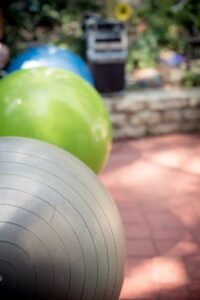How to Choose the Right Stability Ball
 Stability balls are great equipment to add to your exercise arsenal. When choosing a ball, consider there are a few differences and uses for stability balls that you should be aware of before you make a purchase.
Stability balls are great equipment to add to your exercise arsenal. When choosing a ball, consider there are a few differences and uses for stability balls that you should be aware of before you make a purchase.
Stability balls are incredibly versatile. Working out with a stability ball is an easy way to mix up your workout routine. When used for training, stability balls help improve balance and posture, increase core strength and improve coordination. These are areas you may not regularly include when you exercise. Using a stability ball is perfect for a well-rounded routine.
You can purchase a stability ball (see chart in the box for sizes) to assist with your exercises, physical therapy or rehabilitation. Occasionally, stability balls are used in training sessions for those with Parkinson’s disease.
Stability balls can also be incorporated into yoga sessions to add variety. If you practice yoga regularly, you can use a stability ball to increase the difficulty of certain poses.
Choosing the Right Size Stability Ball
Choosing the size of ball depends primarily on your height. When you sit on a ball, you do not want to feel as if you need to squat too low when you sit. Your feet need to touch the floor.
The Right Size for You
The following should act as guidelines, based on your height.
55 cm size if you are 4’11” to 5’4”
65 cm size if you are 5’5” to 5’11”
77 cm size if you are 6’0” to 7’
- It is anti-burst tested and guaranteed. You don’t want to hurt yourself.
- Make sure it comes with a pump and spare pin to keep it inflated. Even quality balls deflate over time.
- It has a non-slip surface. Variations include smooth or ridged texture.
- A good ball should be a good fit and comfortable. It shouldn’t be too squishy or soft
- Size does matter. As you sit on the ball, your knees should be at a 90-degree angle or slightly less when your feet touch the floor. See “Choosing the Right Size Stability Ball” section above.
Watch Part 2 and Part 3 Exercise Snack Videos about Stability Balls.
Part 2 of 3 – Stability Ball Exercises for Upper and Lower Body
Part 3 of 3 – Stability Ball Exercises for Cardio
Regardless of your experience and skill, it is important to perform each movement with the correct technique to minimize the chance of getting hurt.
You want your workout to push you. If it feels like you aren’t working hard, you probably aren’t. Select a workout that matches your skill level. If you are a beginner, keep it simple and as you get more experienced you can try more advanced exercises. Listen to your body. There is a difference between feeling fatigued and pain, a difference between breathing hard and gasping for air. Make sure your workout is challenging, but not too challenging.
You also want a workout that will keep you focused. You do not want to be counting the minutes (which can distract you from what you want to accomplish). Good workouts will make you focus on the movements.
Assuming you continue working out with a stability ball, you also want a routine that produces positive results. Stability ball workouts are a great addition to any routine. Be sure to also respect your body in relation to good diet and sound sleep habits.
Finally, it is very important to feel confident in your workouts. Working out should be a positive experience. Good workouts will make you feel good about yourself.
Of course, regardless of the workout you select, it should be fun, so choose a routine that is engaging. If you aren’t seeing results and you aren’t having fun, it’s probably time to switch routines.
